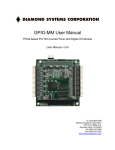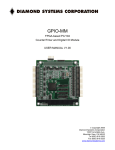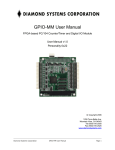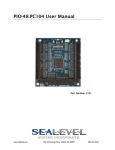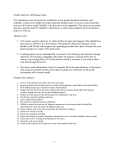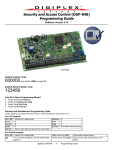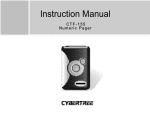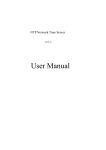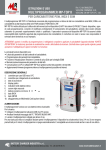Download GPIO-MM-21 User Manual - Diamond Systems Corporation
Transcript
GPIO-MM-21 User Manual FPGA-based PC/104 Digital I/O Module User Manual v1.03 © Copyright 2010 1255 Terra Bella Ave. Mountain View, CA 94043 Tel (650) 810-2500 Fax (650) 810-2525 www.diamondsystems.com Table of Contents General Description.........................................................................................................3 Overview....................................................................................................................3 Digital I/O Features....................................................................................................3 Board Layout....................................................................................................................4 Board Drawing...........................................................................................................4 I/O Connector Pinout.......................................................................................................5 Digital I/O Header Pinout...........................................................................................5 Auxiliary I/O Header Pinout........................................................................................6 Board Configuration........................................................................................................7 Base Address Selection.............................................................................................7 I/O Map..............................................................................................................................8 Register Bit Descriptions................................................................................................9 8255 Data Registers..................................................................................................9 8255 Control and Status Registers (Basic Mode Definition – MSFLAG=1)............10 8255 Control and Status Registers (Bit SET/RESET Mode – MSFLAG=0)............11 Programming Digital I/O................................................................................................12 Overview..................................................................................................................12 96-bit Programmable Direction (8255).....................................................................12 Specifications.................................................................................................................13 General Specifications.............................................................................................13 Additional Information..................................................................................................14 Datasheets...............................................................................................................14 Figures Figure 1: GPIO-MM-21 Board Layout................................................................................4 Figure 2: Set 8255 Base Address to 0330h.......................................................................7 Diamond Systems Corporation GPIO-MM-21 User Manual Page 2 General Description Overview The GPIO-MM-21 is a PC/104 board featuring 96 Digital I/O (DIO) lines. The DIO function is implemented in FPGA cores, emulating quad 82C55A PPI chips. Two 50-pin I/O header provide for external DIO connections. Direction on all ports is selected by programming control registers in the FPGA. 48 I/O lines are buffered with transceivers, whose directions are controlled by logic that responds to the direction control values written to the registers. Each line is capable of sinking 64mA in a logic low state or sourcing 15mA in a logic high state. The board requires only +5V for operation. The remaining 48 I/O lines are capable of +/-24mA per line. DIO headers are organized to allow direct interfacing to OPTO-22s isolated I/O racks, including the G4 series, the PB16-H, -J, -K, -L, PB8H, and the PB24HQ. These racks and I/O modules allow up to 3000 VRMS isolation between the computer and the user's signals. All control signals, power, and ground on the DIO header match the corresponding signals on these I/O racks, so a single 50-pin ribbon cable, such as Diamond Systems' C50-18, is all that is needed to make the connection. Digital I/O Features • • • • Quad 82C55A Parallel Peripheral Interfaces (PPI) logic implemented in FPGA cores. Each 82C55A has three 8-bit I/O ports for a total of 96 DIO lines, which connect to two 50-pin headers for external connections. Port direction and operation is selected through software programmable control registers. 48 lines buffered with transceivers. Diamond Systems Corporation GPIO-MM-21 User Manual Page 3 Board Layout Board Drawing Figure 1: GPIO-MM-21 Board Layout Diamond Systems Corporation GPIO-MM-21 User Manual Page 4 I/O Connector Pinout Digital I/O Header Pinout Connectors J3 and J4 provide a total of 96 general-purpose DIO interfaces. They can be pulled-up to +5V or pulled-down to ground using jumpers J8 and J11 respectively. The following table shows the 82C55A port arrangement. Ports 1 and 2 are on connector J3 and ports 3 and 4 are on connector J4. J3 J4 Port 1A7 1 2 Port 2A7 Port 3A7 1 2 Port 4A7 Port 1A6 3 4 Port 2A6 Port 3A6 3 4 Port 4A6 Port 1A5 5 6 Port 2A5 Port 3A5 5 6 Port 4A5 Port 1A4 7 8 Port 2A4 Port 3A4 7 8 Port 4A4 Port 1A3 9 10 Port 2A3 Port 3A3 9 10 Port 4A3 Port 1A2 11 12 Port 2A2 Port 3A2 11 12 Port 4A2 Port 1A1 13 14 Port 2A1 Port 3A1 13 14 Port 4A1 Port 1A0 15 16 Port 2A0 Port 3A0 15 16 Port 4A0 Port 1B7 17 18 Port 2B7 Port 3B7 17 18 Port 4B7 Port 1B6 19 20 Port 2B6 Port 3B6 19 20 Port 4B6 Port 1B5 21 22 Port 2B5 Port 3B5 21 22 Port 4B5 Port 1B4 23 24 Port 2B4 Port 3B4 23 24 Port 4B4 Port 1B3 25 26 Port 2B3 Port 3B3 25 26 Port 4B3 Port 1B2 27 28 Port 2B2 Port 3B2 27 28 Port 4B2 Port 1B1 29 30 Port 2B1 Port 3B1 29 30 Port 4B1 Port 1B0 31 32 Port 2B0 Port 3B0 31 32 Port 4B0 Port 1C7 33 34 Port 2C7 Port 3C7 33 34 Port 4C7 Port 1C6 35 36 Port 2C6 Port 3C6 35 36 Port 4C6 Port 1C5 37 38 Port 2C5 Port 3C5 37 38 Port 4C5 Port 1C4 39 40 Port 2C4 Port 3C4 39 40 Port 4C4 Port 1C3 41 42 Port 2C3 Port 3C3 41 42 Port 4C3 Port 1C2 43 44 Port 2C2 Port 3C2 43 44 Port 4C2 Port 1C1 45 46 Port 2C1 Port 3C1 45 46 Port 4C1 Port 1C0 47 48 Port 2C0 Port 3C0 47 48 Port 4C0 +5V 49 50 Ground +5V 49 50 Ground NOTE: The connectors on the board are labeled “Port 1” and “Port 2” but do not denote the 82C55A port numbers shown here. Diamond Systems Corporation GPIO-MM-21 User Manual Page 5 Signal Description Port 1A0-Port 1A7 8255-1 Port A, bits 0-7 Port 1B0-Port 1B7 8255-1 Port B, bits 0-7 Port 1C0-Port 1C7 8255-1 Port C, bits 0-7 Port 2A0-Port 2A7 8255-2 Port A, bits 0-7 Port 2B0-Port 2B7 8255-2 Port B, bits 0-7 Port 2C0-Port 2C7 8255-2 Port C, bits 0-7 Port 3A0-Port 3A7 8255-3 Port A, bits 0-7 Port 3B0-Port 3B7 8255-3 Port B, bits 0-7 Port 3C0-Port 3C7 8255-3 Port C, bits 0-7 Port 4A0-Port 4A7 8255-4 Port A, bits 0-7 Port 4B0-Port 4B7 8255-4 Port B, bits 0-7 Port 4C0-Port 4C7 8255-4 Port C, bits 0-7 +5V Ground +5 volt DC from the PC/104 bus. Digital ground from the PC/104 bus. Auxiliary I/O Header Pinout The auxiliary I/O header (J5) is provided for bidirectional, TTL-level, general-purpose I/O. 1 AUXIO_0 2 AUXIO_1 3 AUXIO_2 4 AUXIO_3 5 GND Card Voltage Type Pin Configuration AUXIO_0-AUXIO_3 Four bidirectional, TTL-level, general-purpose I/O signals. GND Diamond Systems Corporation Ground GPIO-MM-21 User Manual Page 6 Board Configuration Base Address Selection Jumper J10, positions 4-9, is used to configure the base address of all four 8255 registers (The 8255 register map occupies 16 bytes of I/O address space, as described in Section 5, I/O Map). Jumper the locations as shown in the table to set the 8255 base addresses. I/O Address 0220h 0240h 0250h 0260h 0280h 0290h 02A0h 02B0h 02C0h 02D0h 02E0h 0300h 0330h 0340h 0350h 0360h 0380h 0390h 03A0h 03C0h 03E0h 9 Out Out Out Out Out Out Out Out Out Out Out Out Out Out Out Out Out Out Out Out Out 8 In In In In In In In In In In In Out Out Out Out Out Out Out Out Out Out Jumper Position 7 6 In In In Out In Out In Out Out In Out In Out In Out In Out Out Out Out Out Out In In In In In Out In Out In Out Out In Out In Out In Out Out Out Out 5 Out In In Out In In Out Out In In Out In Out In In Out In In Out In Out 4 In In Out In In Out In Out In Out In In Out In Out In In Out In In In The following example selects an 8255 base address of 0330h. Figure 2: Set 8255 Base Address to 0330h Diamond Systems Corporation GPIO-MM-21 User Manual Page 7 I/O Map Sixteen registers are used for DIO programming, as shown in the following table. The offsets shown in the table are from the base address set using jumper J10, as described in the Board Configuration section. Offset 00h 8255-1 port A DIO register Description 01h 8255-1 port B DIO register 02h 8255-1 port C DIO register 03h 8255-1 control and status register 04h 8255-2 port A DIO register 05h 8255-2 port B DIO register 06h 8255-2 port C DIO register 07h 8255-2 control and status register 08h 8255-3 port A DIO register 09h 8255-3 port B DIO register 0Ah 8255-3 port C DIO register 0Bh 8255-3 control and status register 0Ch 8255-4 port A DIO register 0Dh 8255-4 port B DIO register 0Eh 8255-4 port C DIO register 0Fh 8255-4 control and status register Diamond Systems Corporation GPIO-MM-21 User Manual Page 8 Register Bit Descriptions Refer to the I/O Map section for the DIO register set list. 8255 Data Registers DIO Base+00h (8255-1 Port A) DIO Base+04h (8255-2 Port A) DIO Base+08h (8255-3 Port A) DIO Base+0Ch (8255-4 Port A) DIO Base+01h (8255-1 Port B) DIO Base+05h (8255-2 Port B) DIO Base+09h (8255-3 Port B) DIO Base+0Dh (8255-4 Port B) DIO Base+02h (8255-1 Port C) DIO Base+06h (8255-2 Port C) DIO Base+0Ah (8255-3 Port C) DIO Base+0Eh (8255-4 Port C) Bit: 7 6 5 4 3 2 1 0 Name: DATA DATA 8-bit parallel data. On reset, the port is set to input mode and the port is held at a logic level 1 until the reset signal is removed. The port remains in input mode until changed using the control register. Following a reset, all lines are set to input mode. Diamond Systems Corporation GPIO-MM-21 User Manual Page 9 8255 Control and Status Registers (Basic Mode Definition – MSFLAG=1) DIO Base+03h (8255-1) DIO Base+07h (8255-2) DIO Base+0Bh (8255-3) DIO Base+0Fh (8255-4) Bit: Name: 7 MSFLAG 6 5 MSELA 4 3 2 1 0 PADIR PCUDIR MSELB PBDIR PCLDIR PCLDIR Port C (lower) direction. Sets the direction of the port C I/O signals 0-3. 0 = output 1 = input ◄ (Reset value) PBDIR Port B direction. Sets the direction of the port B I/O signals. 0 = output 1 = input ◄ (Reset value) MSELB Group B mode selection. Sets the mode of operation for the group B signals. 0 = mode 0 ◄ (Reset value) 1 = mode 1 NOTE: 1. Only mode 0 is currently implemented. 2. All output registers are reset when the mode is changed. PCUDIR Port C (upper) direction. Sets the direction of the port C I/O signals 4-7. 0 = output 1 = input ◄ (Reset value) PADIR Port A direction Sets the direction of the port A I/O signals. 0 = output 1 = input ◄ (Reset value) MSELA Group A mode selection. Sets the mode of operation for the group B signals. 00h = mode 0 ◄ (Reset value) 01h = mode 1 1xh = mode NOTE: 1. Only mode 0 is currently implemented. 2. All output registers are reset when the mode is changed. MSFLAG Mode set flag. Selects the port configuration mode. 0 = Bit set/reset control register mode When MSFLAG is reset, this register is used to set/reset individual Port C bits. 1 = Basic mode definition control register mode ◄ (Reset value) When MSFLAG is set, this register is used for direction and mode selection. NOTE: When the control word is read, the value of MSFLAG is always 1, implying basic control word information is being read. Diamond Systems Corporation GPIO-MM-21 User Manual Page 10 8255 Control and Status Registers (Bit SET/RESET Mode – MSFLAG=0) DIO Base+03h (8255-1) DIO Base+07h (8255-2) DIO Base+0Bh (8255-3) DIO Base+0Fh (8255-4) Bit: Name: 7 MSFLAG 6 5 4 3 - 2 BSEL 1 0 SET SET Bit set/reset individual command. 0 = reset 1 = set BSEL Port C bit select. 0 = bit 0 1 = bit 1 2 = bit 2 3 = bit 3 4 = bit 4 5 = bit 5 6 = bit 6 7 = bit 7 MSFLAG Mode set flag. Selects the port configuration mode. 0 = Bit set/reset control register mode When MSFLAG is reset, this register is used to set/reset individual Port C Bits. 1 = Basic mode definition control register mode When MSFLAG is set, this register is used for direction and mode selection. NOTE: When the control word is read, the value of MSFLAG is always 1, implying basic control word information is being read. Diamond Systems Corporation GPIO-MM-21 User Manual Page 11 Programming Digital I/O Overview GPIO-MM-21 provides 96 DIO lines using an FPGA core implementation of four 8255 devices (8255-1, 8255-2, 8255-3 and 8255-4). All I/O lines contain jumper-selectable 10KΩ pull-up/pull-down resistors. 96-bit Programmable Direction (8255) Operation of the 8255 FPGA core should be as described in the 8255 PPI datasheet. Refer to the 8255 datasheet, Additional Information, for detailed register and programming information. The 8255 has three parallel I/O ports. Ports A and B are 8-bit bi-directional I/O ports. Port C is divided into two 4bit bi-directional I/O ports. For programming, the ports are arranged into two groups, as shown below. Port Group A B Description 8 bits of Port A and upper 4 bits (4-7) of port C. 8 bits of Port B and lower 4 bits (0-3) of port C. NOTE: The port groups can be separately configured for different operating modes. However, GPIO-MM-21 only implements operating mode 0, which provides simple, bidirectional I/O without handshaking. Port C bits may be individually set and reset by setting the MSFLAG in the 8255 Control and Status Register and programming the remaining register bits for the desired bit state. Setting the 8255 Control and Status Register to the following values gives 16 possible I/O configurations. Status and Control Register Bits PADIR PCUDIR PBDIR PCLDIR Group A Port A Port C (upper) Group B Port B Port C (lower) 0 0 0 0 Output Output Output Output 0 0 0 1 Output Output Output Input 0 0 1 0 Output Output Input Output 0 0 1 1 Output Output Input Input 0 1 0 0 Output Input Output Output 0 1 0 1 Output Input Output Input 0 1 1 0 Output Input Input Output 0 1 1 1 Output Input Input Input 1 0 0 0 Input Output Output Output 1 0 0 1 Input Output Output Input 1 0 1 0 Input Output Input Output 1 0 1 1 Input Output Input Input 1 1 0 0 Input Input Output Output 1 1 0 1 Input Input Output Input 1 1 1 0 Input Input Input Output 1 1 1 1 Input Input Input Input Diamond Systems Corporation GPIO-MM-21 User Manual Page 12 Specifications General Specifications • • • • • • • • • • • Base FPGA: Xilinx Spartan II, 200,000 gates, 40K RAM bits Input clock: 40MHz FPGA code storage: Flash memory, field upgradeable via JTAG ID indicator: 8-bit LED display indicates FPGA code personality; field upgradeable via JTAG Programmable I/O: 96, using 2 82C55A cores Output current: • Port 1 unbuffered I/O: +/-24mA per line • Port 2 buffered I/O: Logic 0: 64mA max per line, Logic 1: -15mA max per line Dimensions: 3.55" x 3.775", PC/104 form factor PC/104 bus: 16-bit stackthrough ISA bus Power supply: +5VDC ±5% Operating temperature: -40° to +85° C Weight: 2.2oz Diamond Systems Corporation GPIO-MM-21 User Manual Page 13 Additional Information Datasheets Datasheets provide programming reference information for the DIO functions. 1. 82C55A CMOS Programmable Peripheral Interface , Harris Semiconductor, March 1997 Diamond Systems Corporation GPIO-MM-21 User Manual Page 14














